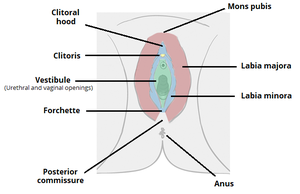Female Genital Tract
This article or area is currently under construction and may only be partially complete. Please come back soon to see the finished work! (11/06/2020)
Original Editor - Khloud Shreif
Top Contributors - Khloud Shreif, Kim Jackson, Anthonia Abraham and Anna Fuhrmann
Introduction[edit | edit source]
The female genital tract consists of the external genitalia or vulva that consists of ( mons pubis, labia majora, labia minora, clitoris, vestibule, hymen, bartholin's glands, external urethra meatus, and skene's gland). The internal genital tract or reproductive system and consists of ( the vagina, uterus, fallopian tubes, and ovaries).
External Genitalia/ Vulva[1][edit | edit source]
Function of external genitalia: protect the internal genital tract from infection, act as a sensory tissues during sexual intercourse, assist in micturition.
Innervation of Vulva, it receives parasympathetic and sensory supply if it is divided into anterior and posterior parts:
Anterior. it is supplied by ilioinguinal nerve L1, the genital branch of the genitofemoral nerve L1,2.
Posterior, pudendal nerve (S2,3,4), posterior cutaneous nerve of the thigh.
Clitoris and vestibule, parasympathetic innervation from the cavernous nerves a branch from the uterovaginal plexus.
Mons Pubis/ Veneris[edit | edit source]
It is a bad of fat located anterior and cover the symphysis pubis underlying the skin, it is covered with hair at puberty.
Labia Majora[edit | edit source]
Two skin fleshy folds, extend posteriorly to mons pubis, the outer skin is covered by hair, the inner surface is smooth, hairless and contain sweat and sebaceous glands that produce lubricant secretion.
Labia Minora[edit | edit source]
Two hairless skin folds lies within and medial to the labia majora.it is about 2 inches wide and surrounds the openings to the vagina and urethra. They meet posteriorly forming skin folds called fourchette. Fourchette separated from hymen by depression named fossa navicularis.
It is rich in blood supply that gives it the bink color, during sexual stimulation it swells and becomes more sensitive to stimulation.
Clitoris[edit | edit source]
It is located between the upper end of the labia minora, formed of erectile corpora cavernosa tissue, and homologous to the penis in the male.
It is sensitive to sexual stimulation can become erect.
Vestibule[edit | edit source]
It is the area between the labia minora where the vagina and urethra open.
Hymen[edit | edit source]
It is a thin membrane of soft tissue covered by stratified squamous epithelium, lies deep to the vestibular orifice. and cover the vaginal orifice. Hymen has many shapes to allow menstrual blood to flow out of the vagina. It is usually torn during the first intercourse.
Bartholin's Glands/ Greater Vestibular Glands[edit | edit source]
Bilateral racemes glands located at the sides of the vaginal orifice. Secret mucous that acts as a lubricant.
Bartholinitis, the bartholin's Glands can be infected or inflamed that can be treated by an antibiotic if it is obstructed it can cause vulva swelling forming a cyst or abscess, in this case, surgical intervention will be the effective treatment.
External Urethral Meatus[edit | edit source]
It opens in the vestibule behind the clitoris.
Skene's Gland[edit | edit source]
It is a paraurethral glands open adjacent to distal urethra.
Skene's duct may be obstructed because the gland is infected causing skene's duct cyst. If the duct is infected it causes recurrent urinary tract infection and if the cyst is larger than 1 cm it cause dyspareunia[2]
Internal Reproductive System[edit | edit source]
Vagina[edit | edit source]
Uterus[edit | edit source]
Fallopian tubes[edit | edit source]
Ovaries[edit | edit source]
Resources[edit | edit source]
References[edit | edit source]
- ↑ Nguyen J, Duong H. Anatomy, Abdomen and Pelvis, Female External Genitalia. InStatPearls [Internet] 2019 Oct 10. StatPearls Publishing.
- ↑ https://www.msdmanuals.com/professional/gynecology-and-obstetrics/miscellaneous-gynecologic-disorders/skene-duct-cyst







